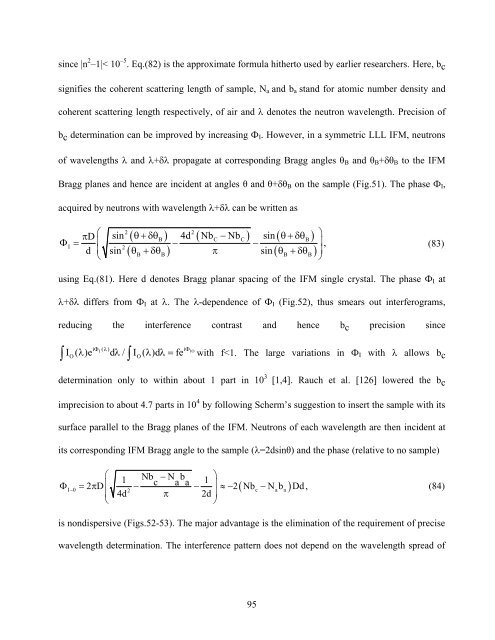PHYS01200804001 Sohrab Abbas - Homi Bhabha National Institute
PHYS01200804001 Sohrab Abbas - Homi Bhabha National Institute
PHYS01200804001 Sohrab Abbas - Homi Bhabha National Institute
You also want an ePaper? Increase the reach of your titles
YUMPU automatically turns print PDFs into web optimized ePapers that Google loves.
since |n 2 –1|< 10 –5 . Eq.(82) is the approximate formula hitherto used by earlier researchers. Here, b c<br />
signifies the coherent scattering length of sample, N a and b a stand for atomic number density and<br />
coherent scattering length respectively, of air and denotes the neutron wavelength. Precision of<br />
b c determination can be improved by increasing Ф I . However, in a symmetric LLL IFM, neutrons<br />
of wavelengths and + propagate at corresponding Bragg angles θ B and θ B +θ B to the IFM<br />
Bragg planes and hence are incident at angles θ and θ+θ B on the sample (Fig.51). The phase Ф I ,<br />
acquired by neutrons with wavelength + can be written as<br />
<br />
<br />
<br />
<br />
<br />
<br />
2 2<br />
D<br />
sin B 4d NbC NbC sin <br />
<br />
B<br />
I ,<br />
2 <br />
d sin B B sin <br />
B<br />
<br />
<br />
B<br />
<br />
(83)<br />
using Eq.(81). Here d denotes Bragg planar spacing of the IFM single crystal. The phase Ф I at<br />
+ differs from Ф I at . The -dependence of Ф I (Fig.52), thus smears out interferograms,<br />
reducing the interference contrast and hence b c precision since<br />
i I ( )<br />
i IO<br />
I<br />
O<br />
( )e d / I<br />
O( )d fe <br />
with f
















